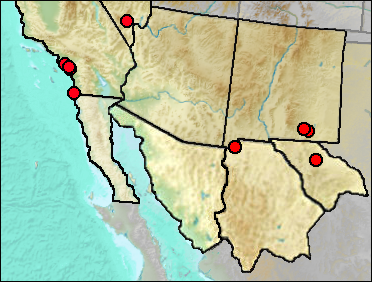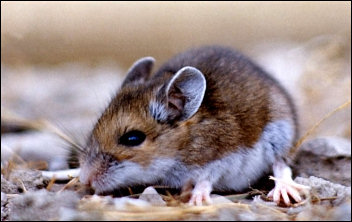Class Mammalia
Order Rodentia
Family Cricetidae
Subfamily Neotominae
Genus Peromyscus

 Peromyscus
maniculatus is a generalist that seemingly fills in regardless of the habitat
whenever other species leave an opening. It thus tends to have relatively low
population numbers on average at lower elevations. However, it becomes the dominant
species in high-elevation coniferous forest in the Southwest. It is expectable that
with increased distribution of such forests, the Deer Mouse would become more common in
our region during full-glacial times.
Peromyscus
maniculatus is a generalist that seemingly fills in regardless of the habitat
whenever other species leave an opening. It thus tends to have relatively low
population numbers on average at lower elevations. However, it becomes the dominant
species in high-elevation coniferous forest in the Southwest. It is expectable that
with increased distribution of such forests, the Deer Mouse would become more common in
our region during full-glacial times.
Fig. 1. Peromyscus maniculatus. National Park Service photograph by John Good.
Cornely et al. (1981), in their survey of Guadalupe Mountains National Park, found Deer Mice associated mostly with desertscrub (one specimen with mixed grassland), and procured none above 1615 m. The modern mammal collection of the UTEP Biodiversity Collections includes the following: of 43 Peromyscus collected around Dry Cave, only one was P. maniculatus; of 10 specimens collected around U-Bar Cave, none was of this species. On the other hand, in a sample of 41 Peromyscus from relatively high areas of the Sacramento Mountains to the north of the Guadalupe Mountains, 70% were P. maniculatus.
Peromyscus maniculatus jaws are most likely to be misidentified as P. eremicus or P. crinitus by discriminant analysis (see taxon accounts of those species for details). The localities listed here are represented by relatively secure identifications.
Peromyscus maniculatus was the second most common Peromyscus identified among the fossil specimens (25 compared to 20 P. nasutus), in agreement with the hypothesized habitat conditions. Dates range from the probable pre-pleniglacial Wisconsin of Dry Cave and mid Wisconsin of U-Bar Cave to the near-terminal Wisconsin deposits of Dry Cave. The specimens earlier identified as P. maniculatus from the Room of the Vanishing Floor, Pit NW Animal Fair, and Camel Room, Dry Cave, appear to represent P. crinitus.
Sites.
Rancholabrean: Centennial Parkway, Las Vegas Valley (Jefferson et al. 2015); Tule Springs (Springer et al. 2005: cf.).
Sangamon: Newport Bay Mesa (Jefferson 1991b).
Wisconsin: Costeau Pit (Jefferson 1991b); Glen Abbey (Majors 1994).
Mid Wisconsin: Pacific City (Wake and Roeder 2009: cf.); U-Bar Cave (UTEP).
Mid/Late Wisconsin: Animal Fair (UTEP); Dark Canyon Cave (UTEP); Tsuma Properties, San Clemente (Jefferson 2014).
Late Wisconsin: Algerita Blossom Cave (UTEP); Animal Fair 18-20 ka (UTEP); Bison Chamber (UTEP); Harris' Pocket (UTEP); Human Corridor (UTEP).
Late Wisconsin/Holocene: Balcony Room (UTEP); Burnet Cave (Schultz and Howard 1935: cf.); Fowlkes Cave (Dalquest and Stangl 1984b).
Withdrawn.
Late Wisconsin/Holocene: Beyond Bison Chamber (Harris 1993c: cf.).
Literature. Cornely et al. 1981; Dalquest and Stangl 1984b; Harris 1993c; Jefferson 2014; Jefferson et al. 2015; Majors 1993; Schultz and Howard 1935; Springer et al. 2005; Wake and Roeder 2009.
Last Update: 7 Jan 2016